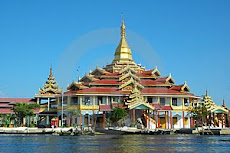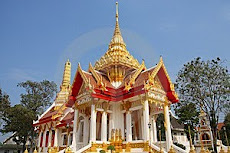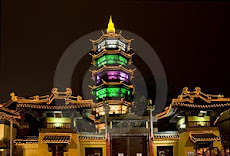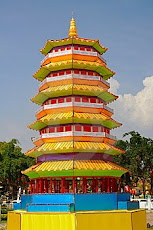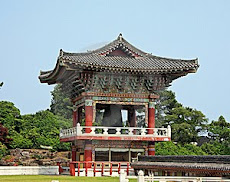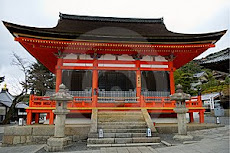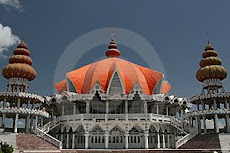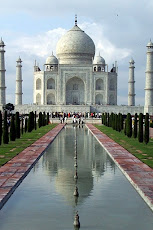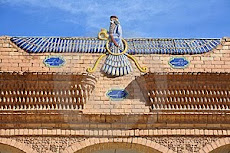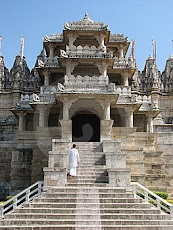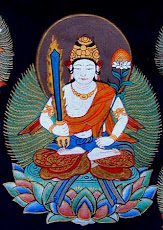Saturday, January 16, 2010
Pure Land Buddhism
Pure Land Buddhism is centred around the Buddha Amitabha (“Infinite-Light”), also known as the Buddha Amitayus (“Infinite-Life”), whose double name is shortened to “Amituo” in Chinese, “Amida” in Japanese and “Adida” in Korean and Vietnamese. Pure Land Buddhism is among the most influential forms of Mahayana Buddhism is described as the Path of Serene Trust, or faith. The object of Pure Land Buddhism is rebirth into the Land of Bliss.
Buddhism spread from India to China, Korea, and Japan, although it has declined in its native India and is almost non-existent, being reabsorbed in Hinduism. Buddhism has evolved many, many forms during its long history, Pure Land Buddhism is one of them. Buddhism offers an excellent way for everyone to realise the ultimate goal of human existence in terms of “attaining enlightenment” through the profound awareness of truth. That is, Buddhism is the means through which everyone, regardless of age, sex, race, or ability can be liberated and attain enlightenment.
Pure Land Buddhism is based on the Pure Land sutras, first brought to China as early as 148 AD, when the Parthian monk An Shìgao commenced translating sutras into Chinese at the White Horse Temple in the imperial capital of Loyang, during the Han. Ching-t’u or Pure Land Buddhism is based on the Sukhvati-Vyuha, which describes the Pure Land and the Amitayur-Dhyana Sutra, a sermon that teaches the way to attain the Pure Land. One key concept behind Pure Land Buddhism is that Nirvana has become increasingly difficult to obtain through meditative practices and Pure Land Buddhism provided a way to practice Buddhism for those who were not capable of practicing other forms. It was popular among commoners and monastics as it provided a straightforward way of expressing faith as a Buddhist. Instead of solitary meditative work toward enlightenment, Pure Land Buddhism teaches that devotion to Amitabha leads one to the Pure Land, where enlightenment can be more easily attained. Pure Land Buddhism is a religion of faith, of faith in Amitabha Buddha [and in one's capacity to achieve Buddhahood]. The essential practice in Pure Land Buddhism is the chanting of the name of Amitabha Buddha (Buddha Remembrance) with total concentration, trusting that one will be reborn in the Pure Land, a place where it is much easier for a being to work towards enlightenment.
Though still in its formative years in the West, Pure Land Buddhism is widely practiced in Asia and its roots extend all the way to ancient India. The number of books written in English on Pure Land Buddhism is steadily increasing, as is the number of translations on the subject from Chinese, Japanese and other languages. Which is one of the aim of this website, to provide more information on Pure Land Buddhism in English.
By PuFA
amituofo.com
Saturday, January 9, 2010
Tibetan Buddhism
Tibetan Buddhism, form of Buddhism prevailing in the Tibet region of China, Bhutan, the state of Sikkim in India, Mongolia, and parts of Siberia and SW China. It has sometimes been called Lamaism, from the name of the Tibetan monks, the lamas [superior ones]. The religion is derived from the Indian Mahayana form of Buddhism, but much of its ritual is based on the esoteric mysticism of Tantra and on the ancient shamanism and animism of Bon, an older Tibetan religion. It is also called Tantrayana [tantra vehicle] or Vajrayana [vehicle of the thunderbolt].
Beliefs and Practices
The most dedicated Tibetan Buddhists seek nirvana, but for the common people the religion retains shamanistic elements. The worship also includes reciting prayers and intoning hymns, often to the sound of great horns and drums. A protective formula of esoteric significance, Om mani padme hum [Om, the jewel in the lotus], is repeated; it is inscribed on rocks and walls, tallied on prayer wheels, and displayed on banners and streamers. In addition to a large pantheon of spirits, demons, and genii, many Buddhas and bodhisattvas (future Buddhas) are worshiped along with their ferocious consorts, or Taras. The monastic orders include abbots, ordained religious mendicants, novices (candidates), and neophytes (children on probation). The standing of nuns is inferior
Early History
The traditional account of its origin is that Buddhism was introduced into Tibet by a Nepali and a Chinese princess, devout Buddhists, who became (7th cent. A.D.) the wives of the Tibetan king Srongtsen Gampo. The new religion was actually established, however, by one of the successors of that king when he called from India the Padmasambhava, a Tantric mystic and teacher who founded (c.750) a Buddhist monastery near Lhasa. Buddhist writings were later translated from Sanskrit in two sections: the Kanjur [translated word], a collection of sacred texts, and the Tanjur [translated treatises], a collection of commentaries (see Buddhist literature).
The early lamas and their successors, constituting the so-called Red Hat sects, rapidly built up power. The Bon shamans, however, fought back successfully, and for over a century the new faith was suppressed. In 1042 a reformer, Atisa (982-1054), a monk from India, arrived in Tibet, unified the priesthood, improved the moral tone by enforcing monastic rules, and tried to eliminate any vestiges of Bon ritual from the religion. He was the founder of the Kadampa sect. Another sect, the Kargyupa, was founded by the translator Marpa (1012-97) and his famous disciple Milarepa.
Tibetan Theocracy
In the 13th cent. Kublai Khan, after his conversion, bestowed temporal rule upon the abbots of the Sakya monastery (and leaders of the Sakyapa sect), who subsequently ruled W Tibet from c.1270 to 1340. The lama Tsong-kha-pa (d. 1419), a great reformer, subsequently reorganized the orders, strengthened monastic discipline, introduced a rigid rule of celibacy, and prescribed rigorous routines for meetings, confessions, and retreats. This reform movement called itself the Gelukpa [virtuous] sect and is generally known as the Yellow Hat sect.
Soon Yellow Hat influence spread to Mongolia, and in 1641 a ruling Mongol prince bestowed temporal and spiritual control of all Tibet upon the fifth grand lama of the order, whose title was Dalai or Ta-lai [ocean-wide] Lama. The Dalai Lama was proclaimed a divine reincarnation of the Bodhisattva Avalokitesvara, ancestor of the Tibetan people, and was installed in the Potala (palace) in Lhasa. He soon became the temporal leader of Tibet, while spiritual supremacy resided with the chief abbot of the powerful Tashi Lumpo monastery near Xigazê, who is known as the Tashi or Panchen Lama. The Panchen Lama is regarded as a reincarnation of Amitabha, the Buddha of Light.
The succession to grand lama, either Dalai or Panchen, depends on direct reincarnation. Upon the death of either, his spirit is believed to pass into the body of some infant just born. An exacting series of tests and divinations determine the proper boy, who is then carefully trained for his great responsibility.
The 14th Dalai Lama was installed in 1940 and the 10th Panchen Lama in 1944. In 1959, following the Tibetan revolt against Chinese rule (see Tibet), the Dalai Lama went into exile in India, and the Chinese installed the Panchen Lama (d. 1989) in his place as ruler. Until the Chinese repression of Buddhism in Tibet in the 1960s, nearly a fifth of the population resided in lamaseries.
Since the 1980s there has been greater tolerance of religious practice in Tibet, although the Chinese government has attempted to exercise control over the religion. In 1995 China rejected the boy who was confirmed by the Dalai Lama as the new Panchen Lama and forced the selection of a different boy, and in Jan., 2000, the head lama of the Karmapa order fled Tibet for India. China subsequently announced (2007) that it would approve any future reincarnation of a Buddha and that only monasteries within China could apply for approval, a move clearly intended to assert China's control over the Dalai Lama's successor.
Source: Columbia Encyclopedia
Beliefs and Practices
The most dedicated Tibetan Buddhists seek nirvana, but for the common people the religion retains shamanistic elements. The worship also includes reciting prayers and intoning hymns, often to the sound of great horns and drums. A protective formula of esoteric significance, Om mani padme hum [Om, the jewel in the lotus], is repeated; it is inscribed on rocks and walls, tallied on prayer wheels, and displayed on banners and streamers. In addition to a large pantheon of spirits, demons, and genii, many Buddhas and bodhisattvas (future Buddhas) are worshiped along with their ferocious consorts, or Taras. The monastic orders include abbots, ordained religious mendicants, novices (candidates), and neophytes (children on probation). The standing of nuns is inferior
Early History
The traditional account of its origin is that Buddhism was introduced into Tibet by a Nepali and a Chinese princess, devout Buddhists, who became (7th cent. A.D.) the wives of the Tibetan king Srongtsen Gampo. The new religion was actually established, however, by one of the successors of that king when he called from India the Padmasambhava, a Tantric mystic and teacher who founded (c.750) a Buddhist monastery near Lhasa. Buddhist writings were later translated from Sanskrit in two sections: the Kanjur [translated word], a collection of sacred texts, and the Tanjur [translated treatises], a collection of commentaries (see Buddhist literature).
The early lamas and their successors, constituting the so-called Red Hat sects, rapidly built up power. The Bon shamans, however, fought back successfully, and for over a century the new faith was suppressed. In 1042 a reformer, Atisa (982-1054), a monk from India, arrived in Tibet, unified the priesthood, improved the moral tone by enforcing monastic rules, and tried to eliminate any vestiges of Bon ritual from the religion. He was the founder of the Kadampa sect. Another sect, the Kargyupa, was founded by the translator Marpa (1012-97) and his famous disciple Milarepa.
Tibetan Theocracy
In the 13th cent. Kublai Khan, after his conversion, bestowed temporal rule upon the abbots of the Sakya monastery (and leaders of the Sakyapa sect), who subsequently ruled W Tibet from c.1270 to 1340. The lama Tsong-kha-pa (d. 1419), a great reformer, subsequently reorganized the orders, strengthened monastic discipline, introduced a rigid rule of celibacy, and prescribed rigorous routines for meetings, confessions, and retreats. This reform movement called itself the Gelukpa [virtuous] sect and is generally known as the Yellow Hat sect.
Soon Yellow Hat influence spread to Mongolia, and in 1641 a ruling Mongol prince bestowed temporal and spiritual control of all Tibet upon the fifth grand lama of the order, whose title was Dalai or Ta-lai [ocean-wide] Lama. The Dalai Lama was proclaimed a divine reincarnation of the Bodhisattva Avalokitesvara, ancestor of the Tibetan people, and was installed in the Potala (palace) in Lhasa. He soon became the temporal leader of Tibet, while spiritual supremacy resided with the chief abbot of the powerful Tashi Lumpo monastery near Xigazê, who is known as the Tashi or Panchen Lama. The Panchen Lama is regarded as a reincarnation of Amitabha, the Buddha of Light.
The succession to grand lama, either Dalai or Panchen, depends on direct reincarnation. Upon the death of either, his spirit is believed to pass into the body of some infant just born. An exacting series of tests and divinations determine the proper boy, who is then carefully trained for his great responsibility.
The 14th Dalai Lama was installed in 1940 and the 10th Panchen Lama in 1944. In 1959, following the Tibetan revolt against Chinese rule (see Tibet), the Dalai Lama went into exile in India, and the Chinese installed the Panchen Lama (d. 1989) in his place as ruler. Until the Chinese repression of Buddhism in Tibet in the 1960s, nearly a fifth of the population resided in lamaseries.
Source: Columbia Encyclopedia
Zen Buddhism
The essence of Zen is attempting to understand the meaning of life directly, without being misled by logical thought or language.
Zen techniques are compatible with other faiths and are often used, for example, by Christians seeking a mystical understanding of their faith.
Zen often seems paradoxical - it requires an intense discipline which, when practised properly, results in total spontaneity and ultimate freedom. This natural spontaneity should not be confused with impulsiveness.
Zen - the word:
'Zen' is the way the Chinese word Ch'an is pronounced in Japan. 'Ch'an' is the Chinese pronunciation of the Sanskrit word Dhyana, which means (more or less) meditation.
Zen - the essence and the difficulty
Christmas Humphreys, one of the leading pioneers in the history of Buddhism in Britain, wrote that "Zen is a subject extremely easy to misunderstand." He was right.
Zen is something a person does. It's not a concept that can be described in words. Despite that, words on this site will help you get some idea of what Zen is about. But remember, Zen does not depend on words - it has to be experienced in order to 'understand'
Enlightenment is inside
The essence of Zen Buddhism is that all human beings are Buddha, and that all they have to do is to discover that truth for themselves.
All beings by nature are Buddhas,
as ice by nature is water.
Apart from water there is no ice;
apart from beings, no Buddhas.
Hakuin Ekaku
Zen sends us looking inside us for enlightenment. There's no need to search outside ourselves for the answers; we can find the answers in the same place that we found the questions.
Human beings can't learn this truth by philosophising or rational thought, nor by studying scriptures, taking part in worship rites and rituals or many of the other things that people think religious people do.
The first step is to control our minds through meditation and other techniques that involve mind and body; to give up logical thinking and avoid getting trapped in a spider's web of words.
History
Zen Buddhism was brought to China by the Indian monk Bodhidharma in the 6th century CE. It was called Ch'an in China.
Zen's golden age began with the Sixth Patriarch, Hui-neng (638-713), and ended with the persecution of Buddhism in China in the middle of the 9th century CE. Most of those we think of today as the great Zen masters came from this period. Zen Buddhism survived the persecution though it was never the same again in China.
Zen spread to Korea in the 7th century CE and to Japan in the 12th century CE. It was popularised in the West by the Japanese scholar Daisetz Teitaro Suzuki (1870 - 1966); although it was found in the West before that.
TopZen in practice
Learning Zen
If you're a westerner you may find it hard to shake off the intellectual and dualist ways of thinking that dominate western culture: these can make it difficult for westerners to come to Zen.
Zen Buddhists pay less attention to scripture as a means of learning than they do to various methods of practising Zen. The most common way of teaching is for enlightenment to be communicated direct from master to pupil.
Zen practices are aimed at taking the rational and intellectual mind out of the mental loop, so that the student can become more aware and realise their own Buddha-nature. Sometimes even (mild) physical violence is used to stop the student intellectualising or getting stuck in some other way.
Students of Zen aim to achieve enlightenment by the way they live, and by mental actions that approach the truth without philosophical thought or intellectual endeavour.
Some schools of Zen work to achieve sudden moments of enlightenment, while others prefer a gradual process.
Clues to the meaning of Zen
Because Zen is so hard to explain here are some quotations that may help you get an idea of it:
The essence of Zen Buddhism is achieving enlightenment by seeing one's original mind (or original nature) directly; without the intervention of the intellect.
Zen is big on intuitive understanding, on just 'getting it', and not so hot on philosophising.
Zen is concerned with what actually is rather than what we think or feel about what is.
Zen is concerned with things as they are, without trying to interpret them.
Zen points to something before thinking, before all your ideas.
The key to Buddhahood in Zen is simply self-knowledge.
To be a human being is to be a Buddha. Buddha nature is just another name for human nature - true human nature.
Zen is simply to be completely alive.
Zen is short for Zen Buddhism. It is sometimes called a religion and sometimes called a philosophy. Choose whichever term you prefer; it simply doesn't matter.
Zen is not a philosophy or a religion.
Zen tries to free the mind from the slavery of words and the constriction of logic.
Zen in its essence is the art of seeing into the nature of one's own being, and it points the way from bondage to freedom.
Zen is meditation.
Subscribe to:
Comments (Atom)



